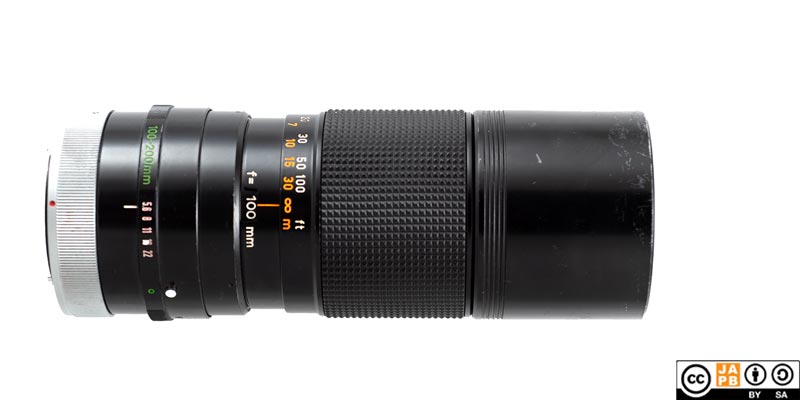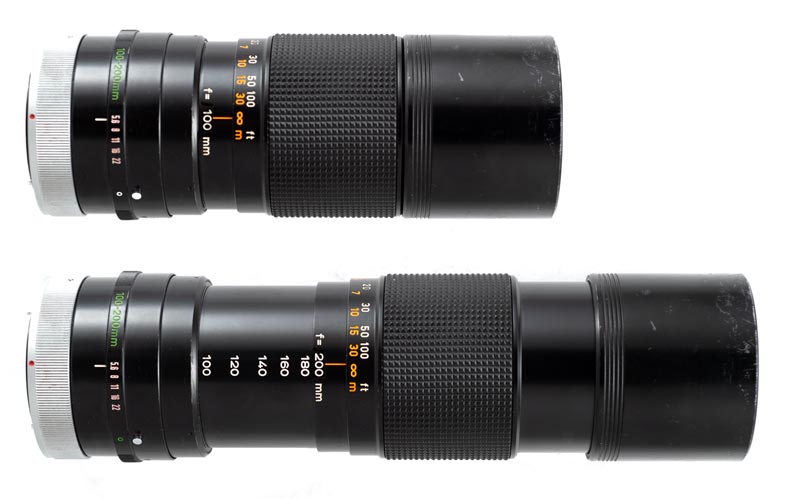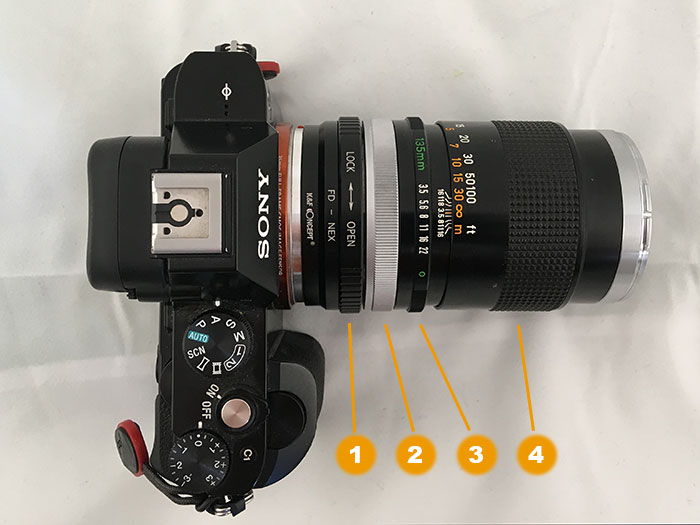Pekka Buttler, 06/2024

Specifications
The table below summarises the lens’ key specifications (measurements based on pictured sample):
| Brand: | Canon | Lens name | Zoom Lens FD 100-200 mm 1:5.6 S.C. |
| Focal length(s)1 | 100-200 mm | Angle-of-view2 | 24°–12° |
| Maximum Aperture | f/5.6 | In Production | 1973–1979 |
| Lens mount | Canon FD | Subfamily (if applicable) | FD black nose |
| Length3 | 176,1 mm | Diameter4 | 66,1 mm |
| Filter ring diameter | 55 mm | Weight | 778 grams |
| Lens element count | 8 | Lens group count | 5 |
| Aperture blades (S/R/C)5 | 8 S | Focus throw | 180 ° |
| Minimum focusing distance | 2,5 m | Maximum magnification | 1:10,4 |
| Has manual aperture ring | YES | Has Manual focus ring | YES |
| Aperture mechanism type | Automatic | Aperture click stops 6 | 5.6•8•11•16•22 |
Further notes:
• This is a relatively early tele zoom lens.
• With its relatively unassuming (8 element) construction, this lens was always intended to be Canon’s budget tele zoom.
• With its maximum aperture of f/5.6, it can by no means be characterised as a bright lens.
• It’s a one-ring design: you push the ring to zoom from 100 mm to 200 mm and you rotate the ring for focusing.
• While not precisely parfocal, the lens is parfocal at infinity and close to parfocal at shorter (≈3 m) range.
• The lens features a built-in, extendable lens hood.

(top) zoomed to 100 mm with hood retracted
(bottom) zoomed to 200 mm with hood extended.
History of Canon FD lenses
Feel free to browse the JAPB article on the Canon FD mount for all the details. Below is an outline of the position of the Canon FD mount in Canon’s development trajectory:
• 1959–1963: R-mount. Canon’s first SLR lens mount. Breech lock-type mount with aperture semi-automation (camera is able to stop down lens for taking the shot, but lens needs to be opened up by user action) .
• 1964–1969: FL-mount. Breech-lock type mount, physically similar mount as Canon R-mount, but camera-to-lens communication linkages somewhat different. Cannot communicate selected aperture to body (stop-down-metering only).
• 1970–1978: FD-mount. Breech-lock mount. FD lenses compatible with FL-cameras and vice versa. Manual focus lenses that communicate aperture information to camera, hence opening the door for automatic exposure (both shutter priority and aperture priority possible)
• 1979–1986: new FD-mount (a.k.a. FDn). Bayonet mount, backwards compatible with FL and FD mounts. Otherwise, as FD mount.
• 1987–today: EF-mount. Electronically controlled autofocus lenses that use an internal focusing motor. Compatible with previous mount lenses only using an adapter with optics.
The era of the Canon FD mount can be characterised by a gradual shift towards the ever-increasing use of plastics and lighter materials. In the chronology of this gradual shift:
• Chrome nose FD lenses (1971–1973) are solid metal (often brass), glass and (synthetic) rubber.
• Black nose FD lenses (1973-≈1975) are also metal, glass and rubber, but often 5-10% less heavy than chrome nose lenses.
• Late FD, (≈1975–1979) rubber is replaced by plastic and heavier metals are gradually replaced by lighter alloys
(FDn lenses (1979–1987) typically make extensive use of light alloys as well as, increasingly, plastics while in the EF era (1987 onwards) plastics fully take over)
Another noteworthy point is related to the S.C. and S.S.C. acronyms found on some FD lens’ name rings: S.C. stands for “spectra coating”, while S.S.C. stands for “super spectra coating”. Both are proprietary marketing names for Canon’s optical coating technology. In theory S.S.C. is always a superior form of coating, but that does not mean that one should always try to get an S.S.C. lens, because:
• S.C. and S.S.C. are first and foremost marketing terms, that were not used on early Canon FD lenses, nor on most FDn lenses. Hence, a FDn lens is certain to have at least the level of coating of its direct (FD) predecessor, even though the S.S.(C.) marking is missing from the lens.
• Coating technology developed a lot during the 70s and 80s. A late S.C. coating is liable to be better optimised than an early S.S.C. coating.
Related versions
The 100-200 mm f/5.6 design was one of Canon’s earliest zooms, and it stayed in production all the way through to the FD-era. Even though zoom technology developed significantly in those years, the basic optical recipe of the 100–200/5.6 stayed essentially unchanged. On some level, the Canon engineers must have gotten it right from the beginning.
The genealogy of the 100-200/5.6 can be briefly summarised as:
• FL 100-200 mm f/5.6 (1966–1971), 8 elements in 5 groups, 8 blades, 55 mm filter, 650 grams
• FD 100-200 mm f/5.6 (1971–1973), 8 elements in 5 groups, 8 blades, 55 mm filter, 820 grams
• FD 100-200 mm f/5.6 S.C. (1973–1979), 8 elements in 5 groups, 8 blades, 55 mm filter, 780 grams [this lens]
• FDn 100–200 mm f/5.6 (1979–19807), 8 elements in 5 groups, 52 mm filter, 6 blades, 610 grams
Adapting
This lens cannot be used natively on any current SLR or dSLRs. To use it in its native environment, you will need a Canon FD or FL-mount film body.
Thanks to being a fully manual lens (manual aperture, manual focus), the lens can be adapted to all mirrorless cameras using a suitable adapter. However, for the adapter to allow the lens to stop down, you will need an adapter that can be set to engage the FD lens’ aperture control lever. Personally, this is my biggest gripe with the FD-mounts as this leads to what I refer to as the four-ring problem:

[1] Activation ring for aperture control
[2] Locking ring for breech-lock mount
[3] Aperture ring
[4] Focus ring
Note, that especially the first three rings are very close together.
Moreover, a large range of special adapters (helicoid adapters, tilt/shift adapters, speed boosters) for using Canon FD lenses on most mirrorless systems are available.
Using Canon FD lenses on dSLRs is a possibility, but is not problem free. Thanks to the relatively short flange focal distance of the Canon FD mount (at 42,0 mm, clearly shorter than that of any full-frame dSLR mount), any adapter will necessitate some corrective optics to achieve infinity focus.
Footnotes
- Focal length is (unless stated otherwise) given in absolute terms, and not in Full-frame equivalent. For an understanding of whether the lens is wide/tele, see ‘Angle-of-view’. ↩︎
- Picture angle is given in degrees and concerns the diagonal picture angle. Rule of thumb:
> 90 ° ==> Ultra-wide-angle
70–90 ° ==> Wide-angle
50–70 ° ==> Moderate wide-angle
40–50 ° ==> ‘Standard’ or ‘normal’ lens
20–40 ° ==> Short tele lens
10-20 ° ==> Tele lens
5-10 ° ==> Long tele lens
< 5 ° ==> Ultra-tele lens ↩︎ - Length is given from the mount flange to the front of lens at its shortest. ↩︎
- Diameter excludes protrusions such as rabbit ears or stop-down levers. ↩︎
- S=straight; R=rounded; C=(almost)circular at all apertures. ↩︎
- Numbers equal aperture values on aperture ring; • intermediate click; – no intermediate click. ↩︎
- There is some guesswork involved in dating the end of production, because Canon online sources do not list the end dates for production.
However, in 1980 the Canon FDn 100–300/5.6 was introduced. While the FDn 100-300/5.6 was a tad more expensive than the FDn 100–200/5.6 (59 000 vs 43 000 yen), it was still clearly priced below the more pro offering (the 80-200/4 at 100 000 yen). Hence, I find it likely that the introduction of the 100-300/5.6 spelled the end of production for the aged 100-200/5.6… ↩︎